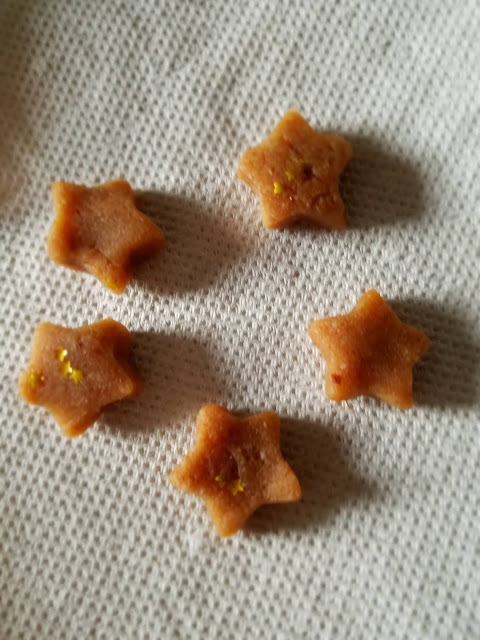Taken from
Gent KANTL 15, volume 1: [
Nyeuwen Coock Boeck, C. Muusers (trans.)]:
1.32. Om mosterdsaus te maken
Neem wat appelmoes en doe er wat mosterd bij met wat gemalen paradijskorrels. Meng dit samen goed.
1.32. To make mustard sauce
Take some applesauce and add some mustard with ground grains of paradise. Mix this well together.
The first recipe to come together is this sweet mustard that will be served alongside the pork. It reads very simply. I do feel that I should make a period "Apple Sauce" to add the mustard to, in order to ensure that the flavor is as authentic as I can make it.
Into the rabbit hole....
Ein Buch von guter spise is a logical source. It is dated between 1345 and 1354, a bit early for most of the reciepts that I will be using, but how much could a basic apple sauce change?
The recipe reads thus:
(69.) Ein apfelmus.
Wilt du machen ein apfelmus. so nim schöne epfele und schele sie. und snide sie in ein kalt wazzer. und süde sie in einem hafen. und menge sie mit wine und mit smaltze und ze slahe eyer mit wiz und mit al. und tu daz dor zu. und daz ist gar ein gut fülle. und versaltz niht.
Google Translates offers this rather hilarious translation:
Will you make an apple sauce. so take beautiful apples and scold them. and cut it into cold wazzer. and south you in a harbor. and mix them with wine and with smaltze and ze slahe eyer with wiz and with al. and close it. and there is even a good fullness. and not oversalted.
Pretty funny, right? Further research found that this recipe is rather common and has been translated from by multple sources whom I consider peers. Dan Myer's offers this translation on his
Medieval Cookery site.
How you want to make an apple puree. So take fine apples and skin them. And cut them in a cold water. And boil them in a pot. And mix them with wine and with fat and also beat eggs with white and with all. And do that thereto. And that is a very good filling. And do not oversalt. [Ein Buch von guter spise]
Ingredients for Applesauce
Apples
Wine
Fat (butter or lard)
Eggs
Salt
I find these ingredients confusing, because the addition of fat and eggs means that the sauce itself will be thicker and richer and not what we traditionally think of when we think of applesauce. Traditional fats in medieval cooking were lard, oils, and when available butter. It reminds me a little bit of lemon curd recipes (eggs, sugar, butter and lemon zest and juice).
It's been ages since I made mom's lemon curd, but that is the recipe I first look up. Here it is:
Mom's Lemon Curd
Juice of 2-3 lemons ~1/3 cup
Zest of 1 lemon
4 egg yolks
2/3 cup granulated sugar
6 tbsp. butter
pinch of salt
This gives me an approximate idea of how much of each ingredient for the interpreted recipe I will need.
Here are my guesses at interpreting the recipe:
Wine would substitute for the juice of the lemon.
Apples to replace lemon zest and lemon juice.
2 Whole eggs instead of four egg yolks
No Sugar??
Keep salt to enhance flavor and please modern tastes
No Spices???
Interpreted Recipe
1-2 Apples, peeled, cored and cut into chunks - Use a mix of apples - better flavor
2 whole Eggs
~ 1/3 cup wine - use lemon juice in lieu of wine for more "child friendly" sauce
up to 6 tbsp. of butter
salt
*Opt. Sugar and Spices
Following the recipe, the apples should be peeled and cored and added to a pot with water. The assumption is that you boil them until they are soft and then mix the softened apples with wine, butter and then the eggs to thicken it. At the end of the recipe salt is mentioned so salt should also be added. Noteably what is missing are spices! You would expect to have spices in this sauce. The only flavorings are the apples and the wine.
Having made lemon curd in the past I know that I am going to use a double boiler to create this dish. I know my first step will be to cook the apples until they are soft in either water or the wine/lemon juice, and since I want this to be a sauce, I know I will puree the apples before moving into the next step.
The next step will involve heating the pureed apples with the eggs, sugar and the eggs until the eggs are fully cooked --approximately two to three minutes - at which point I will add in the butter a tablespoon at a time until the mixture begins to thicken. I assume that like lemon curd, apple curd can be stored in sterilized jars up to a month or so.
I am wrestling with the idea that there is no sugar or spices, and after the first test, I may add sugar to it. We will see. The other recipe I found for applesauce in lent also foregoes sugar, so it may not have been used in this region during this period.
1.16. Appelmoes in de vastentijdNeem appel, geschild en in stukken gesneden. Doe ze in een pot, neem de lever van kabeljauw of schelvis en laat deze met de appels koken. Roer het vaak. Wrijf saffraan fijn. Stoot dan [de saffraan] in [het appelmengsel] en vermeng het met amandelmelk. Pureer het als het klaar is, schep het op schotels en strooi er specerijen bovenop.
1.16. Apple sauce in Lent
Have apples, peeled en cut in pieces. Put them in a pot, take the liver of cod or haddock and bring this to the boil with the apples. Stir it frequently. Grind saffron finely. Pound [the saffron] in [the apples] and temper with almond milk. When it is ready purée it, serve it on plates and sprinkle spices on top.
Modern Adaptation:
Medieval Apple Sauce
Day 2: Moving Forward and testing this recipe to make apple curd
Time to test making apple curd- because I do not have wine we will be using water and lemon juice to cook the apples. I only have medium eggs available, and I'm using three apples that are past their eating prime--yay me. With those exceptions I will be using the recipe I created yesterday. If it works, I will be adding mustard and grains of paradise to it. I must confess that while I've made mustard from scratch in the past, I currently use a stoneground mustard that is pre-made.
Test Results
I followed the recipe for the applesauce exactly as I wrote it. It does create a soft pale colored sauce that is very "fragrant" with apples, however the texture is not what I would think of as modern "Applesauce"--it is a sauce, similar to a gravy. With the savory flavoring of butter and egg so prevalent this dish could be offputting if it was not served correctly--as a sauce.
If I were to serve this as a side dish, I would add some sugar or honey to enhance the sweetness a little bit more, and cut down on the butter and egg..maybe using half as much as the recipe called for,
As a savory sauce--it is good, and it was a great way to use up older apples that were starting to go a bit mealy. That said, I moved ahead and prepared it with the mustard. I was very aggressive with the seasoning for the mustard and veered off from just the grains of paradise. I found a recipe for a traditional sweet german mustard and used just the spicing from that.
For the mustard part of this dish I used stoneground mustard mixed 1/3 with dijon mustard.
Spice Mix
4 Juniper Berries
1/2 tsp. Grains of Paradise
4 Cloves
8 Black Peppercorns
It is currently mellowing in the fridge so the flavors can meld together. I will test it next week. The guinea pig enjoyed the mustard sauce and pronounced it good.
No pictures as yet, because this is just a test run.
On to the next rabbit hole.....
11/9/2021 - Update
I had to do more research on the applesauce...I thought perhaps I had misunderstood what kind of an apple sauce was needed. I may need to rethink the recipe above based on this recipe I found while rsearching "apple sauce".
Sabrina Welserin suggests this as a proper sauce for game and small birds.
8 To make a sauce with apples for game and small birds
Take good apples and peel them and grate them with a grater and put a little fat in a pan over [the fire] and let it become hot and put the apples in it and let them roast therein. After that put good wine thereon, sugar, cinnamon, saffron and some ginger and let it cook together for a while, then it is ready. One should boil the small birds first and then roast them in fat.
Instead of a smooth sauce I might be looking at a chunkier sauce of apples cooked with wine, spices and then mustard added?? Time to research the roast and to determine how much is too much on spicing.













